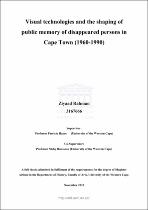| dc.contributor.advisor | Hayes, Patricia | |
| dc.contributor.author | Rahman, Ziyaad | |
| dc.date.accessioned | 2022-03-30T08:09:41Z | |
| dc.date.available | 2022-03-30T08:09:41Z | |
| dc.date.issued | 2021 | |
| dc.identifier.uri | http://hdl.handle.net/11394/8992 | |
| dc.description | Masters of Art | en_US |
| dc.description.abstract | The starting point of this thesis is the work of the Truth and Reconciliation Commission
(TRC) and the Missing Person’s Task Team (MPTT), two instruments of the post-apartheid
government, both of which have directly attended to the disappeared dead. The disappeared
dead are defined in this thesis as persons abducted and subject to enforced disappearances, as
well as those killed in other political circumstances whose bodies were buried by the
apartheid state, in some cases as unnamed paupers, thus denying families the opportunity to
bury and mourn according to familial or cultural norms. Today the MPTT still seeks to locate
the gravesites of the disappeared dead, to exhume, identify and to return the mortal remains
to their families. | en_US |
| dc.language.iso | en | en_US |
| dc.publisher | University of the Western Cape | en_US |
| dc.subject | Visual technologies | en_US |
| dc.subject | Truth and Reconciliation Commission (TRC) | en_US |
| dc.subject | Missing Person’s Task Team (MPTT) | en_US |
| dc.subject | Cape Town | en_US |
| dc.subject | Post-apartheid government | en_US |
| dc.title | Visual technologies and the shaping of public memory of disappeared persons in Cape Town (1960-1990) | en_US |
| dc.rights.holder | University of the Western Cape | en_US |

